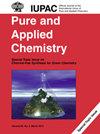过去就是未来:从天然酸碱指示剂到可持续分析化学中的天然试剂
IF 2
4区 化学
Q3 CHEMISTRY, MULTIDISCIPLINARY
引用次数: 0
摘要
本文回顾了历史上自然资源在分析化学中的应用。早在 16 世纪 50 年代,化学中就使用植物提取物作为指示剂来鉴别液体的酸碱性。后来,随着工业革命改变了人们的生活,人们改用合成化学品。由于物理学和技术的进步,现代分析技术取代了传统技术。工业革命曾是一个令人兴奋的时代,直到工业排放的有毒污染物严重破坏了人类和环境。绿色化学和绿色分析化学的概念作为解决问题的潜在方案被提出。最近,人们重新考虑了使用天然提取物作为化学分析试剂,认为这是一种可持续的替代方法。虽然人工智能(AI)等新技术将影响分析化学发展的未来趋势,但其主要目标是实现可持续分析化学,包括使用天然试剂、减少化学品消耗量和废物产生量。本文章由计算机程序翻译,如有差异,请以英文原文为准。
The past is the future: from natural acid-base indicators to natural reagents in sustainable analytical chemistry
This article reviews the use of natural resources in analytical chemistry throughout history. Plant extracts were employed as indicators in chemistry for identifying the acidity or alkalinity of liquids as early as the 1650s. Later, as the industrial revolution altered people’s lives, synthetic chemicals were used instead. Modern techniques of analysis have replaced conventional ones as a result of advancements in physics and technology. The industrial revolution was an era of excitement until the toxic pollutants released from industries severely damaged people and the environment. The concepts of green chemistry and green analytical chemistry were proposed as potential solutions to the problems. The use of natural extracts as chemical analysis reagents has been reconsidered recently as a sustainable alternative. While new technologies such as artificial intelligence (AI) will influence future trends in analytical chemistry development, the primary goal is to move toward sustainable analytical chemistry, which includes using natural reagents and reducing the amount of chemicals consumed and waste produced.
求助全文
通过发布文献求助,成功后即可免费获取论文全文。
去求助
来源期刊

Pure and Applied Chemistry
化学-化学综合
CiteScore
4.00
自引率
0.00%
发文量
60
审稿时长
3-8 weeks
期刊介绍:
Pure and Applied Chemistry is the official monthly Journal of IUPAC, with responsibility for publishing works arising from those international scientific events and projects that are sponsored and undertaken by the Union. The policy is to publish highly topical and credible works at the forefront of all aspects of pure and applied chemistry, and the attendant goal is to promote widespread acceptance of the Journal as an authoritative and indispensable holding in academic and institutional libraries.
 求助内容:
求助内容: 应助结果提醒方式:
应助结果提醒方式:


